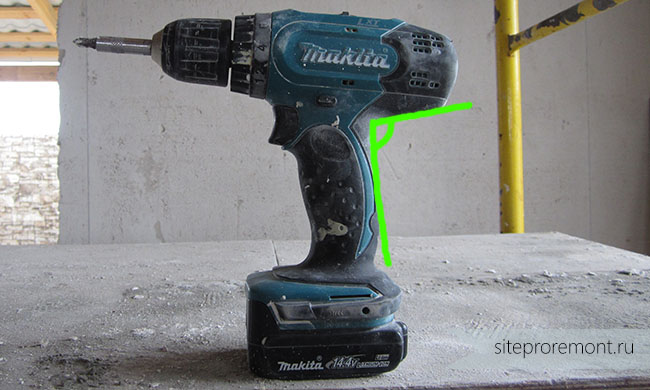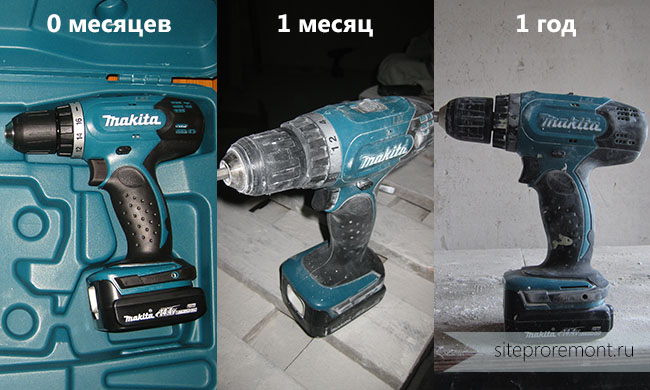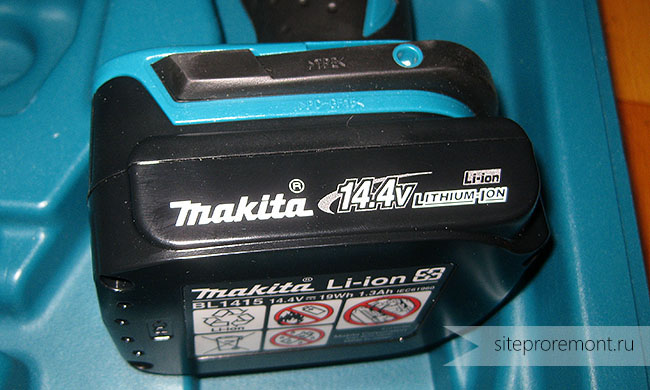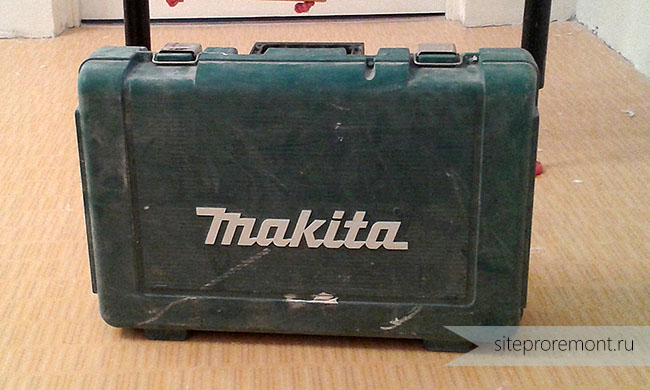Hello dear readers! Since you are reading this material, it means, almost certainly, you have conceived, or are already doing repairs at home. Perhaps you want to assemble a plasterboard ceiling, or maybe you decided to build a house for a cat on your own or a gazebo in the yard ...
In order to work effectively and get good results, you need a good tool. In particular, a screwdriver. In this article, we will understand what it is, what it is for, and, most importantly, how to choose a screwdriver.
Of course, we will consider a cordless tool, since it is 100,500 times more convenient, and not simple screwdrivers that can only tighten screws, but drills and screwdrivers. If only because the simple ones are not sold anymore. D-Sh, as you understand, can also drill, but where in the repair without this?
The screwdriver is a special hand-held power tool, which is important, with an adjustable torque. It is designed for tightening (and, of course, unscrewing) screws, self-tapping screws, screws and all such fasteners + for drilling holes. Outwardly it looks like such a fat pistol.
Criterias of choice
Since this is not just another useless female “rag”, but a modern complex mechanism, as a rule, people take its choice seriously. What criteria are important when choosing it?
- Brand name
- Dimensions, shape, ergonomics
- Battery capacity and type
- Torque, impact function
- Drilling diameters of various materials
- Supply voltage
- Contents of delivery
Let's go through each of these points in more detail.
World manufacturers of screwdrivers
In most hardware stores, you can find products from companies such as:
- Bosch (Germany)
- Makita (Japan)
- AEG (Germany)
- Hitachi (Japan)
- Hilti (Liechtenstein)
- DeWalt (Germany)
- Black & Decker (USA)
- Metabo (Germany)
- Interskol (Russia)
- Bison (Russia)
- Sparky (Germany)
- Skil (Netherlands)
As you can see, the choice is mega-size, but I want to warn you right away that most of the above is made in China anyway. But from my own experience, I can say that this is certainly not a bad thing. Disputes about which is better: Bosch or Makita, Hitachi or AEG do not subside ... I will express my personal opinion. Bosch makes things of average performance at a fairly high price. But, in general, the tool of this company serves for a long time. And this is from the experience of my colleagues. Metabo is about the same. Although, it seems like, in the new models they have a lot of smart electronics crammed into it, like an electronic torque limiter.
Makita is a recognized golden mean, and it is believed that their instrument is the best in terms of price / quality ratio. They are especially good at screwdrivers. I adhere to the same point of view at the moment. I have a puncher and a shura Makita - no problem. And I am not distinguished by any kind of concern for technology in this regard. According to rumors, Makita makes screwdrivers for NASA astronauts. Hitachi has about the same image, perhaps a little simpler.
Until recently, I almost did not see the AEG tool in people, only once I worked them with a grinder. But more recently, my father bought himself their D-W, and I can say - the unit is more than worthy, for its price. For 5500 rubles, it has 2 Li-Ion batteries of 1.5 Ah each, 14 V power supply, 36 Nm torque and even an LED charge indicator built into the batteries! I like it. So I do not exclude the purchase of an instrument from AEG in the future.
American brands are not very popular with us. It seems that because of the prices. Or maybe it's the service.
Hilty in my understanding is a show-off divorce. Space price, average performance. Their trick is in some special conditions of guarantee and service, but on the other hand, again, I heard that their tool breaks not so rarely. For example, what Hilty gives:
- No costs for the first two years of tool life. Even if something breaks down, a representative of the company will personally come to you, take the tool from you, repair it free of charge and deliver it back to you
- Lifetime manufacturer's warranty
- After two years of service, the owner pays a maximum of 33% of the price for repairs
Of course, all this is very cool, but for the money that they ask for their instrument, you can buy 2-3 Makita similar in characteristics. And buying Hilty for home use is generally nonsense. Where it will be in place is at construction sites, where the tool is taken by everything, where it is dropped, koatsya, etc. There he will live longer than the others, and the guarantee will come in handy.
For the home, just the right thing - Interskol. Inexpensive and sufficiently high-quality equipment. Yes, it looks dumb, yes, relatively bulky, but it works. They haven't written anything good about Skill for a long time)) Sparky is also less and less often found on sale.
As for the prices for screwdrivers, if you need a high-quality, but at the same time, simple tool for installing, for example, plastic panels in the bathroom at home, count on the price of 3000 - 4500 rubles. Almost all Interskols, several Makit and Hitachi go at this price. Anything that costs more is for the most part useful to professionals.
Dimensions, ergonomics
This point is not important for every home craftsman, but it is very relevant for the pros who work with screwdrivers for hours. I will say the following - size matters. But the meaning is twofold. On the one hand, a small screwdriver is better, the hand does not get so tired from it, it crawls into hard-to-reach places. But, at the same time, it is more difficult for them to tighten the self-tapping screw!
I don't know what exactly is the matter here, but a heavy tool easily sticks self-tapping screws into profiles. And this is not only my observation.
And still, personally, I am a supporter of compact models. My "shura" is one of the smallest in Makita's lineup. And I'm not so comfortable working with larger models. But I use it mainly for the installation of gypsum board. For those who work with wood or often drill, large and powerful models are more suitable.
Sharp angle at Bosch
Now about ergonomics. The first step before buying is to take the tool in the palm of your hand and pay attention to the handle. The main scourge of many models is the sharp angle between the "barrel" and the handle. The consequences of such a seemingly trifle are a stable callus between the thumb and forefinger.

Obtuse angle at Makita screwdriver
My "sidekick" has this angle obtuse (almost straight), and I have no calluses.
This is perhaps the main potential jamb allowed by the developers of the tool. The speed switches for the vast majority of screwdrivers are located in the same way - on top. There are only inconvenient buttons for switching the direction of rotation. On my Makita, for example, you can't just press the right button - it's too close to the palm, and the button itself is too small.

By the way, you can see one of Makita's flaws in the photo above. He is only a year old there, I looks like he is 40 years old)) If you clean it, then at 30. It pisses me off that this is a completely Japanese instrument, and the inscription "Makita" is all peeled off, as are the inscriptions of the torque limiter divisions on the body.
Batteries
An extremely important criterion for choosing a screwdriver. In modern cars, 3 types of batteries are used: Nickel-cadmium (NiCd), nickel-metal hydride (NiMH) and lithium-ion (Li-Ion).
Advantages of nickel-cadmium batteries:
- This is the only type of battery that can be stored in a completely discharged state.
- Low price
- Frost resistance
- Recovery after long-term storage
Disadvantages:
- Sufficiently short life time - about 1000 charge / discharge cycles
- Relatively low specific capacity (up to 2 Ah)
- "Memory effect" - the battery can be charged only after a complete discharge, otherwise its capacity in the next cycle will decrease by the amount of underdischarge
- High self-discharge - charged, put in a suitcase for a week, got out - but the battery is discharged
- Harm to the environment - a controversial disadvantage, of course
First of all, these batteries are still in demand only because of their low price.
Benefits of Nickel-Metal Hydride Batteries:
- Environmentally friendly
- Smaller dimensions compared to NiCd
- Poorly pronounced "memory effect"
- High specific capacity
Disadvantages:
- Lifetime even shorter than NiCd - 500 cycles
- Higher price compared to NiCd
- High self-discharge (up to 10% in the first 24 hours after charging)
- Impossibility of storage in a completely discharged form
- Sensitivity to negative temperatures
Nickel-metal hydride batteries are not widely used today, because lithium-ion batteries are much cooler.
Advantages of lithium-ion batteries for screwdrivers:
- Very high specific capacity
- There is practically no "memory effect"
- Minimum self-discharge (20% per year for a fully septic battery at room temperature)
- Minimum charging time (my batteries charge in half an hour)
- 3-4 times longer life than NiCd batteries
Disadvantages:
- High price (not only batteries, but also a charger)
- Inability to start charging at full discharge (modern batteries have built-in various control systems, so this drawback has been eliminated)
- High sensitivity to negative temperatures

Compact Li-Ion battery
Of course, it makes no sense for a home to purchase a tool with expensive Li-Ion batteries. NiCd will do just fine. But for the pros, there is only one option - to take Li-Ion. I have something to compare with, and if I have to buy a screwdriver again, I will only take with lithium-ion batteries.
Another important battery parameter is capacity.
Most budget screwdriver models are equipped with 1.3 Ah batteries. If we take as an example the work of assembling a plasterboard ceiling at an average pace, then the charge of one (new) battery will last for 3-4 hours, no less. Considering that modern batteries get infected, at most, in an hour - you will never be idle. Even if you drill wood or metal without interruption (and this is better done with an ordinary drill, you must agree), then discharge such a battery in just about an hour.
Who needs 2 or even 3 Ah batteries - these are the happy owners of "Thor's hammers" - mega-powerful impact screwdrivers. They are so cool that they come with a handle just like a hammer drill! There is also another special caste of "shura" - a special tool mainly for drilling wood and metal. Their rotation speed of the chuck reaches 4000 rpm, while in conventional machines, on average, up to 1300 rpm.
I present to your listening a video, which tells about the criteria for choosing a screwdriver, it will be useful to watch:
Impact, torque, drill diameters
As for the blow function, the overpayment for it is relatively small (500 - 1000 rubles), so the purchase of such a tool for the home seems to me to be quite justified. Of course, if you have a new building and you need to make several hundred holes in the concrete, a screwdriver will not help you, you will have to take a hammer drill.
The maximum torque allows you to judge what types of work the "Shura" is generally suitable for. Roughly speaking, KM reflects how powerfully the instrument turns. Normal specimens have a KM of at least 24 Nm (Newton meters), which is quite suitable for installing drywall and building a hut. 30 or 36 Nm is generally a beauty, they drill the tiles with crowns without any problems. Everything that is higher is already more for drilling in metal and wood.
For example, a screwdriver with a torque of 36 Nm can drill wood with a drill with a maximum diameter of 25 mm. And a tool with a CM of 80 Nm is already 65 mm. The difference is obvious. The characteristics always indicate the maximum diameter of the drills for wood, metal and concrete, if it is percussion. So figure out what you are going to drill and choose the right tool for yourself.
Supply voltage, scope of delivery

Plastic suitcase from a screwdriver
Typically, the supply voltage directly determines the power of the instrument. Here, the higher the voltage, the higher the maximum torque. I see no reason to explain in more detail.
As a rule, the delivery set of screwdrivers includes a plastic case (or bag) for carrying, the tool itself, two batteries, a charger, at least 1 bit and instructions. Some manufacturers can supplement the kit with a flashlight, some with a set of bits. In this, manufacturers are not very different from each other. But these kind of nice little things can play a decisive role in your choice. For example, if you choose from two similar models.
Chucks for the overwhelming majority of screwdriver models are quick-clamping, convenient. For the spindle, forced braking is already used everywhere - when you release the trigger, the tool stops turning instantly, without any inertia. If there is no such brake in some model, do not buy it, this is the last century.
In conclusion, I can also tell you about one useful feature used in the coolest instrument models - the impulse mode. Twisting in it occurs in measured jerks, which makes it much easier to start drilling (the drill takes less to the side) and twisting / unscrewing the self-tapping screws with the "killed" slot. For the pros, this feature is very relevant.
Perhaps that's all, we have learned a lot about how to choose a screwdriver. I also recommend crawling YouTube, there are a lot of different videos with specific instrument models. I found my model)
Subscribe to fresh articles site if you find it interesting! See you later!

